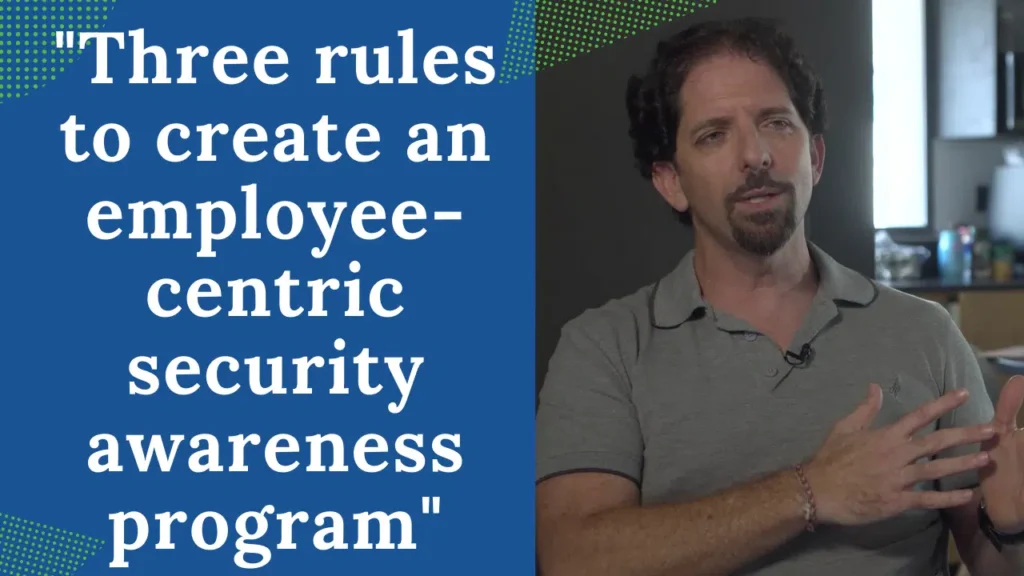The Ultimate Guide to Security Awareness Training
At CybeReady, we believe that security awareness training should be easy, effective, and even fun for employees.
These short Best Practices videos will help you turn your cybersecurity culture around.
Please feel free to share them with your team or anyone else who may find this Guide helpful!
Cyberattacks are a constant threat to every organization today. Protecting against cyberattacks puts significant pressure on employees to do their part in protecting themselves, your organization, and your organization’s assets, including your customers. One proven way to reduce the risk of cyberattacks is through an effective cyber security awareness training program.
Employees are both the first and last line of defense against a possible attack, making cyber security awareness training critical to your company’s overarching security strategy. Effective cyber security awareness training programs incorporate customizable, short content bites right into the employee workflow and measure success based on critical data points—not click rates.
However, not all companies keep current on their training content or practices. They might run the same tedious, time-consuming program year after year, failing to engage their employees or change their organization’s cyber security culture. Or even worse, they might not conduct any cyber security training at all.
Whether your company falls into this category or has experienced one too many cyberattacks, it’s time to change your security awareness program. This guide is for security and cyber security executives and professionals who need data-driven, behavior-changing cyber security awareness training for their employees.
This guide explains what you need to know about cyber security awareness, including:
- A look at what cyber security is and isn’t
- Why you need cyber security now more than ever
- Key cyber security awareness terms you should know
- Why you can’t afford one-size-fits-all cyber security awareness programs
- Seven steps to create effective cyber security awareness in your organization
- Tips you can’t afford to miss when implementing cyber security awareness
- Essential must-have resources to keep handy
What is cyber security awareness
Cyber security awareness is a mix of knowledge, attitudes, and behaviors that employees demonstrate to protect their organization and its assets. It includes security protocols and governance for handling systems, software, hardware, networks, data, and even building security. These protocols may address password settings, authentication, authorized access, data loss and privacy, physical security, and regulatory compliance.
Traditional cyber security awareness programs are based on annual presentations, video-based training, or testing on security protocols. This one-and-done approach covers several topics at a time, making it more challenging for employees to retain and practice what they’ve learned.
However, more progressive programs occur year-round by providing continuous learning. They use shorter content bites and real-world simulations that are easier for employees to understand and retain. It’s provided right in their workflow and is customized for each person’s role and localization.
When successful, cyber security awareness instills in employees the ability to understand:
- Threats your company is at risk for
- Signs to identify those threats
- Protocols to prevent threats
To achieve the greatest impact, make cyber security awareness training part of your entire cyber security culture.
Why cyber security awareness is important
Technology impacts your life and livelihood every day. Whether you’re at home, at work, or on the go, you likely have access to a device that’s connected to a network. Having that on-the-go access requires a sense of shared responsibility for everyone to follow safety protocols while online.
Keep reading to learn more reasons cyber security awareness is important. For each one, you’ll see that having the most sophisticated threat detection and protection software and security tools isn’t enough to deter cybercriminals. Through clever techniques and unbeatable determination, these criminals pride themselves in finding the weakest spots, particularly where humans are involved. To prevent such attacks, ensure cyber security awareness is a core component of your organization’s overall security program.
Cybercrime rates are on the increase
As the world isolated during the COVID-19 pandemic, hackers became savvier than ever. In 2020, the FBI’s Internet Crime Complaint Center reported a 300 percent increase in reported cybercrimes, logging 2,474 formal ransomware-related complaints on its site.
Over the past few years, ransomware attacks have exploded as new groups have come out of the woodwork, each with its own ransomware variants. Within the first six months of 2021, the volume of ransomware attacks increased 151 percent worldwide compared to mid-year 2020.
Phishing—another cyberthreat—reigns as the type of attack to most likely cause a data breach. As reported in a recent study from Proofpoint, 75 percent of organizations worldwide experienced a phishing attack in 2020. Among those attacks, 74 percent that targeted US businesses were successful despite phishing awareness training for employees. Mobile phishing—also referred to as SMS phishing or smishing—increased over 300 percent from 2Q to 3Q 2020 according to Proofpoint data. And a SlashNext study discovered a 3,000 percent increase just in COVID-19-related URLs alone.
Humans are the biggest vulnerability for a cyberattack
Humans are naturally prone to making mistakes, especially when it comes to cyber security. In a 2014 IBM Cyber Security Intelligence Index Report, researchers found that humans are the major cause in 95 percent of all breaches. This fact rings true today as cybercrime rates continue to increase.
Egress Research found that, between 2020 and 2021, 94 percent of organizations had an insider data breach, of which almost 75 percent resulted from employees breaking security rules. In the same report, 84 percent of IT leaders who were surveyed indicated the primary cause of serious incidents was human error.
More employees are working from home
Security firm Tessian recently conducted a survey on working from home. In response to their survey, over half of senior IT professionals and employees indicated an increase in poor cyber security habits since more employees started working from home. The transition has caused employees to become lax in following security awareness practices. The survey found employees feel less intimidated by IT protocols when they’re at home compared to when they worked in an office pre-pandemic.
Also, in the hasty switch from office to the home office, many companies moved their company communication to personal e-mail accounts. This approach doesn’t allow for two-factor authentication, which is also prone to becoming an attack vector, making it easier for attackers to gain unauthorized access.
Industry security compliance requirements have become more stringent
Organizations that follow government, industry, or other regulations know all about compliance, especially security compliance. Whether General Data Protection Regulation (GDPR), Health Insurance Portability and Accountability Act (HIPAA), Service Organization Control (SOC) 2, or other standards, each one enforces general information security compliance. In addition, they require companies to implement cyber security protections to prevent an attack and protocols to follow in case one happens.
As the types, frequency, and intensity of attacks increase, regulators strengthen their requirements, with hefty penalties for organizations that violate these rules. As an example, HIPAA violations range from $100 to $1.5 million annually. To avoid these fines, companies must pass compliance. If an attack occurs, they must contain and mitigate it, as well as report it to law enforcement and federal agencies.
Cyberattacks are expensive
Head-lining ransomware attacks, like the Colonial Pipeline hack, have detrimental financial impacts on their targets. The attack on this major US pipeline operator shut down half of the gasoline, jet fuel, and diesel supply along the East Coast for over a week. To recover their stolen data, Colonial Pipeline paid their attackers the equivalent of $5 million in Bitcoin. However, for each major breach, dozens or hundreds of attacks occur against smaller businesses that are just as devastating for them and their customers.
Ransomware has emerged as a major security threat for organizations around the world. In the US alone, it’s estimated that $350 million was paid out for ransomware attacks in 2020. In a report from cyber security Ventures, ransomware attacks are expected to increase from $20 billion in 2021 to $265 billion in 2031.
Cyber security risks are here for the long haul
As technology continues to evolve and expand in the areas of the Internet of Things (IoT), cloud, network, and data management, hackers will persist in their mission to meet these innovations head-on. As they succeed in their attacks, they will continue to intensify the damage and lasting impact they create. Despite cyber security protection strategies from the DevOps and DevSecOps level all the way to mobile networks, hackers will continue to look for the weakest link—human error.
The case for cyber security awareness across all organizations has never been more critical. Protect your organization and its assets with a comprehensive solution that includes cyber security awareness training for your employees.
Cyber security awareness terms you must know
- Breach: Unauthorized entry to gain access to computer data, applications, networks, or devices. Also referred to as a security breach or data breach.
- Compliance: The act of applying effective technical and practical security measures to meet the regulatory or contractual requirements of a third party. Examples include SOC 2, HIPAA, and GDPR.
- Cyberattack: An attempt to gain unauthorized access and cause damage to a computer, system, or network. The goal is to destroy or control technology systems, with the intent to change, delete, lock, or steal the data within them.
- Cybercrime: Malicious use of technology or technological devices for the purpose of stealing information or causing damage. Examples include phishing, identity theft, hacking, and other social engineering attacks.
- Cyber security: Protection against unauthorized access to the ecosystem of technical devices, networks, hardware, software, systems, and the information inside them.
- Deep fake: Use of artificial intelligence to manipulate the spoken words, mannerisms, and expressions of a person originally recorded as audio or video. Used to spread false information or propaganda.
- Denial of Service (DoS) attack: An attack intended to make a machine or network inaccessible to its authorized users.
- Hacker: A person who uses technical skills and technology to gain unauthorized access to systems, networks, or data to commit crimes.
- Malicious actor: An entity that has the potential to partially or wholly break through an organization’s IT security. Also referred to as a threat actor.
- Malware: Harmful computer programs that hackers use to gain access to sensitive information and create destruction. Examples include viruses, worms, and trojans. Malware is short for malicious software.
- Man-in-the-middle attack: A way for an attacker to secretly eavesdrop or modify traffic between two parties to steal credentials or personal information or to destroy or corrupt data.
- Phishing: A type of attack that disguises email or text messages as coming from a popular brand, such as PayPal or Netflix. It uses trickery to deceive recipients into clicking a link or entering credentials intended to compromise devices and steal information.
- Ransomware: A type of malware intended to block access to an organization’s computer system or data. It encrypts files so the attackers can steal data or demand a ransom to unlock it.
- Risk: The probability of exposure or loss that can result from a cyberattack or data breach.
- Security: In IT, the people, policies, and tools are in place to protect an organization’s assets and property.
- Security posture: The state of an organization’s cyber security readiness as demonstrated by its employees and technology to protect its IT infrastructure, network, information, and equipment from an attack.
- Simulation training: Used in cyber security training to mimic real-life attacks as they occur in an employee’s workflow.
- Spear phishing: A type of phishing that’s based on previously gathered information—such as names, addresses, and social security numbers—about a target that’s publicly available or gained from a data breach.
- Threat: The possibility of an attack to gain unauthorized access to, damage, or steal information, intellectual property, or data. Also referred to as a cyber threat. Can come from inside or outside an organization.
- Trojan horse: A type of malware or virus (malicious code or software) that’s disguised to look legitimate, but that takes control of a computer to damage, harm, or steal data or information on a network.
- Virus: Malicious code (malware) that spreads through devices to damage them or steal the data within them.
- Voice phishing: A type of phishing that uses a voice over a phone to trick victims into entering their usernames, passwords, and other sensitive credentials on a specific website.
- Vulnerability: A flaw in software code, system misconfiguration, or security practices that hackers use to gain unauthorized access to a system, network, or data.
- Whaling: A type of phishing attack that tricks C-suite employees into falling for some sort of emergency where they click a link or attachment that installs malware or steals sensitive information.
- Worm: A self-replicating program that spreads across a network in search of security holes with the intent to steal sensitive information, corrupt files, or gains remote access to the system.
- Zero Trust: A security approach based on the concept that all users—both inside and outside an organization’s network—must have security authentication, authorization, and validation before gaining access to applications or data.
Refer to these terms as you gain insights into the challenges and gaps in existing awareness training methods and justification for deploying an effective cyber security awareness training program.
Problems with one-size-fits-all cyber security awareness programs
A contributing factor to breaches—whether from an internal or external attacker—is an absent or ineffective cyber security awareness program. Look at the following four common problems of ineffective cyber security awareness training.
One-size-fits-all training material
Training all employees on the same content doesn’t benefit anyone. One-size-fits-all training material is often part of learning through in-person presentations, video series, extensive required reading or annual cyber security awareness month events. These approaches don’t factor in the unique cyber security and learning needs of each employee as it pertains to their role in the company. And for global organizations, it doesn’t accommodate the localization needs of employees who speak multiple languages or come from varied ethnic and cultural backgrounds.
Your cyber security awareness program must enable you to tailor the information to each employee based on their job role, language, localization, and learning needs.
Content overload
Content-heavy programs have become the norm for many organizations. These programs include large content libraries and elaborate videos that companies make accessible to employees to consume, learn, and generate change for their cyber security culture. The training provides general information on several topics but doesn’t allow for depth on any one topic. The effect of this content dump on employees leads them and their organizations to fail when it comes to being cyber-aware and cyber-ready.
Employees demonstrate greater cyber security awareness when they receive small bits of information about one topic at a time. They learn little by little about a specific threat, such as phishing, at a deeper level over time. This approach not only engages them in the learning process, but it gives them greater confidence to understand the threat and know how to react and respond to it.
Insufficient opportunities to learn and practice
Cyber security training that’s conducted once or twice a year is ineffective, as demonstrated by the increase in the number of cyberattacks caused by human errors. When your employees receive a plethora of content at one time, they become overloaded with information they’ll soon forget.
An effective cyber security awareness training program occurs continually, at regular intervals. It meets your employees right where they use it most—in their workflow. This way, they’ll retain and use the information regularly to the point it becomes second nature to them—like riding a bike.
Lack of feedback
How do you know if you’ve learned something correctly when you don’t have feedback to guide you? cyber security awareness training programs that take the one-and-done approach don’t allow for giving employees direct feedback. Without it, an employee is likely to make a mistake that leads to a cyberattack. By then, any feedback is too late.
Creating cyber security awareness requires constantly giving employees opportunities to learn through various exercises and simulations. When they receive immediate feedback about those activities, they have an opportunity to internalize the information, learn it better, and practice it.
How to create cyber security awareness
Cyber security awareness fails when companies use the cookie-cutter approach—the same training program for all employees. They might require employees to endure a long presentation, training video, or documentation on a broad set of security topics. Despite employee participation in these learning activities a few times a year, this watered-down approach simply doesn’t work. It neglects to have any positive impact on modifying employee behaviors toward security awareness.
Follow these key steps to create an effective cyber security awareness program for your employees.
1. Focus on the most critical behavior
When you’re starting out – first take the story back to the beginning: what did you try previously, and why didn’t it work for your organization?
To kick off your cyber security awareness program, take inventory of the threats with the highest risk to your company. Then, identify the most important one, such as phishing.
Security awareness programs that try to cover several topics don’t go deep enough to enable employees to fully grasp and retain the information. Instead, by focusing on one critical threat, you can customize your solution to address that specific need. When you continuously train employees on this threat, you help them gain greater understanding and confidence to handle it. You also end up modifying their behavior to prevent them from falling prey to an attacker.
As employees show progress in understanding and applying the training on that specific threat, you can then introduce a new threat into your cyber security awareness program.
2. Create an employee-centric program
Implementing an effective security awareness program that sticks means centering on your employees’ needs for learning. Create short, accessible, and digestible content that they can consume immediately when it arrives at the right time in their workflow. Giving employees access to the content they can engage in enables greater success in modifying their behaviors toward the threat of focus in that training.
Security awareness programs that force large quantities of information on employees are intimidating and overwhelming, making it difficult for them to engage. However, effective security awareness programs enable employees to opt-in and consume meaningful, relatable content that makes sense to their role in the organization. They enable localization so your global employees have access to the same information in their language with respect to their ethnic and cultural differences.
3. Choose text-based content in shorter bites
Skip the long presentations, videos, and security documentation. Instead, use shorter, text-based content. With access to these nuggets of information, employees can quickly scan the content before they begin so they know what to expect.
Training by using long-form content is repetitive and boring. Employees lose interest before they’ve even reached the midpoint. When cyber security awareness content is provided in shorter, text-based bites, employees know what’s coming. Also, when you slice the training into shorter bites, your employees engage with it more easily and retain the information longer. Plus, you can adapt the training to your organizational needs as they change over time.
4. Continuously train employees
To consistently improve the education gap in your cyber security training and boost employee behavior, continuously train and test your employees. This approach doesn’t mean creating highly customized, sophisticated spear-phishing attacks for a group of employees, only for the attacks to slip right past them. Even hackers don’t have that luxury. These approaches have proven time and again that the resources spent in creating these types of attacks don’t correspond to protecting organizations from an actual phish.
Instead, continuously train employees by providing simple phishing attacks that you customize relevant to your employees’ roles in the organization. When your cyber security awareness training program is based on machine learning, you focus on the scams that are likely to be effective within each employee group, by location, team, department, or other differentiators. With this approach, you train and test all employees every month, rather than just a small group of employees some of the time.
5. Measure program effectiveness, not click rates
Most security programs measure participation, such as who enrolled, watched the videos, or interact with the content—referred to as click rates. However, these metrics mean nothing about the training program’s effectiveness on employees.
Click rates don’t mean anything. Context means everything. Measure the effectiveness of cyber security awareness training program with the actional data it generates. Program metrics identify who failed a test the first time, who improved their behavior from one month to the next, who struggles to learn the material (your repeat offenders), and more. These data points allow you to build an effective security platform to train your staff and provide proof to show management the program really works.
6. Identify and reduce the number of high-risk employees
One area that’s essential to consider is your high-risk employee group. For starters, you need to identify who they are, and here’s your first hint: these are not the employees who click on the most phishing simulation links.
High-risk employees are most likely to open you up to a cyber threat. These employees aren’t beginner learners who don’t what to look for yet in a scam. They’re the ones who have difficulty learning the skills to evade phishing scams and need extra training or defenses to meet the threat.
To manage these employees, first, identify which ones are high risk. Then, reduce the number of high-risk employees with effective security training that changes behavior. Finally, as a last line of defense, contain the threats your high-risk group can expose you to.
7. Prove the ROI of your cyber security awareness program with data storytelling
More than anything, company leaders and managers want to see the return on investment (ROI) for their security training. Therefore, your goals for the program must align with theirs.
To prove the effectiveness and success of your cyber security awareness training program, use the data your employees generate as they complete the training. Include storytelling or context to explain the program’s business benefits. Highlight key areas such as whether you’ve reduced the high-risk group boosted engagement or improved the security culture across the organization.
Tips for cyber security awareness
Don’t let your organization fall victim to a cyber security attack. Incorporate these top 13 can’t-miss cyber security tips into your organizational cyber security awareness strategy.
- Create a cyber security culture within your organization that values security, not expediency.
- Stay current with industry compliance and regulations as they apply to your organization.
- Provide effective anti-phishing training through repetitive simulations integrated into your employees’ daily workflow.
- Protect your organization’s sensitive information by maintaining oversight on how it’s stored, retrieved, and accessed.
- Create a security checklist for remote workers—whether they’re on the road or comfy at home—to make it easier for them to comply with your security policy.
- Lockdown your data center by enforcing security policies that track on-premises and remote access.
- Establish personnel, policies, and tools to monitor third-party services as part of your supply chain.
- Secure your software layer through regular software and security updates.
- Require multi-factor authentication beyond a simple password to mitigate security failure.
- Use a scientific training method that aggregates real-world phishing attempts and phishing training simulations.
- Tailor content to each employee’s needs for learning, job role, and globalization.
- Conduct real-world simulations that smoothly integrate into an employee’s workflow.
- Continuously train in small bites for optimal retention and behavioral change.
Invest in a scientifically proven cyber security awareness program that supports your organization in meeting all 13 of these tips.
Resources for cyber security awareness
As you plan your cyber security awareness training, keep in mind the following resources. Each one highlights unique challenges that you can overcome by choosing an effective cyber security awareness program as described in this guide.
Overcome global challenges
For multinational companies, designing security awareness training comes with many pitfalls. They include the writing quality of the content, delivery timing of the training, localization considerations, and visual elements. To address these challenges, provide your global employees cyber security awareness training that has the following qualities:
- Is free of grammatical errors, colloquialisms, and gender bias
- Aligns with working hours and avoids holidays
- Uses culturally appropriate language
- Displays design and color suitably for employee sentiment and engagement
Learn more about global challenges with these 6 tips to overcoming global challenges in employee security awareness training.
Comply with SOC 2 requirements
SOC 2 compliance ensures organizations have proper procedures in place to safeguard private information and quickly mitigate cases when data leaks happen. Originally part of the American Institute of CPAs’ Service Organization Control reporting platform, SOC 2 compliance has become the seal of approval required by organizations to assure customers that their personal information is secure.
To ensure your organization passes SOC 2 compliance, you must complete these seven steps:
- Identify and mitigate risks.
- Develop a communication and training strategy.
- Define controls for high-risk areas.
- Gain buy-in from stakeholders.
- Establish internal control monitoring.
- Monitor third-party providers.
Conduct a pre-audit readiness and risk assessment.
Learn what each step entails and download a corresponding checklist in The Only SOC 2 Compliance Checklist You Need.
The State of cyber security Awareness Training
Technology-based security solutions, like firewalls, endpoint detection, and response solutions, secure email gateways, desktop antivirus, infrastructure as code security, and cloud-based threat filtering, are critical to your security infrastructure. Just as important to their effectiveness in protecting your networks, data, and applications are the people who interact with them.
In a survey conducted by Osterman Research, 75 percent of security decision-makers indicated significant concern over phishing attacks. Of these respondents, 58 percent view awareness training as superior to technology to tackle phishing. The survey also found that awareness training budgets are increasing faster than budgets for technology-based solutions. However, despite employees receiving more training, they aren’t showing a significant change in behavior. Learn more about the findings in this report in The State of Security Awareness Training.
Prepare for National cyber security Awareness Month
In 2021 alone, cybercrime attacks are expected to cost $6 trillion worldwide, and by 2024, they’re expected to reach $10 trillion. The financial impacts are more than any organization or its victims can bear. But you can work to prevent it and minimize the potential damages. It starts with your own employees as your first line of defense.
Each October is National Cyber Security Awareness Month to emphasize the importance of being cyber-aware—both in and away from the workplace. Although this event lasts just one month, the impact keeps going all year long. Learn how to prepare for this annual event and maximize its impact in Essential Toolkit for National cyber security Awareness Month.
Put your cyber security plan into action
In this guide, you learned about the qualities of an effective cyber security awareness program. In summary, make sure you include these seven essentials for every cyber security awareness employee training program:
- Provide ongoing employee cyber security education to create both awareness and change.
- Give employees a hands-on learning approach that they can regularly put into practice.
- Segment groups from low risk to high risk so you can target interventions for each group based on their risk level.
- Leverage data to generate the predictive analytics you need to optimize your employees’ learning experiences.
- Provide real-time feedback to show employees the security gap that exists between them and the organization.
- Drive cultural change that tackles your employees’ attitudes and beliefs about threat risks and attacks head-on.
- Invest in a scientific training method based on machine learning that leverages data to optimize the learning experience for each employee.
Adopt these seven essentials for your cyber security awareness employee training program to reduce malicious attacks caused by employee error.
Take a self-guided virtual tour
See how a fully automated cyber security awareness platform works in this self-guided tour. This tour takes you through BLAST phishing simulations, continuous awareness bites (CAB) security awareness training, and reporting and data management. This hands-on opportunity is one you can’t afford to miss.


















